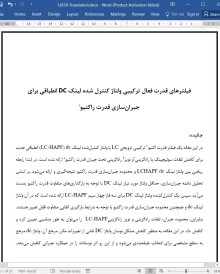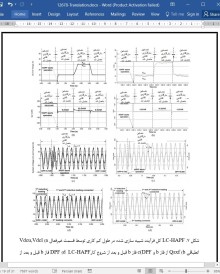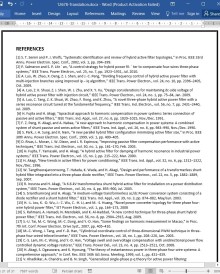
دانلود مقاله فیلترهای قدرت فعال ترکیبی ولتاژ کنترل شده لینک DC انطباقی برای جبران سازی قدرت راکتیو
چکیده:
در این مقاله یک فیلتر قدرت اکتیو ترکیبی تزویجی LC با ولتاژ کنترلشده لینک dc (LC-HAPF) انطباقی جدید برای کاهش تلفات سوئیچینگ یا راهگزینی و نویز راهگزینی تحت جبران قدرت راکتیو ارائه شده است. در ابتدا رابطه ریاضی بین ولتاژ لینک dc LCHAPF و محدوده جبرانسازی قدرت راکتیو نتیجهگیری و ارائه میشود. بر اساس تحلیل دامنه جبرانسازی، حداقل ولتاژ مورد نیاز لینک DC با توجه به بارگذاریهای متفاوت قدرت راکتیو بدست میآید. سپس یک کنترلکننده ولتاژ لینک DC برای سه فاز چهار سیم LC-HAPF ارائه شده است که در آن ولتاژ لینک dc و همچنین محدوده جبرانسازی قدرت راکتیو با توجه به شرایط بارگیری القایی متفاوت قابل تغییر هستند. بنابراین، محدوده جبران، تلفات راهگزینی و نویز راهگزینی LC-HAPF را میتوان به طور مناسبی تعیین کرد و کاهش داد. در این مقاله، به منظور کاهش مشکل نوسان ولتاژ DC ناشی از تغییرات مکرر مرجع آن، ولتاژ dc مرجع به سطح مشخصی برای انتخاب طبقهبندی میشود و از این رو اثر نوسانات را در عملکرد جبرانی کاهش میدهد. سرانجام، شبیهسازی این کار و نتایج آزمایش یک LC-HAPF مرکزی سه فازی چهار سیم برای تأیید اعتبار و اثربخشی طرح LC-HAPF با ولتاژ کنترل شده لینک DC در جبرانسازی قدرت راکتیو پویا ارائه شده است.
1. مقدمه
از نخستین باری که فیلترهای قدرت فعال (PPFها) در اواسط دهه 1940 نصب شد، PPFها به طور گستردهای بنا به دلایلی همچون هزینه پایین، سادگی و راندمان بالا، برای حذف هارمونیکهای جریان و جبران قدرت راکتیو در سیستمهای قدرت توزیع شده مورد استفاده واقع شدند [1]. متأسفانه PPF ها دارای معایب بسیاری از جمله عملکرد پویای پایین، مشکلات رزونانس و ویژگیهای فیلتری هستند که به راحتی تحت تأثیر تغییرات اندک پارامترهای سیستمی قرار میگیرند [2] - [9]. از آنجایی که نخستین بار مفهوم «فیلتر قدرت AC فعال» توسط جیوجی در سال 1976 ساخته شد [1],[7] مطالعات تحقیقاتی در مورد فیلترهای قدرت فعال (APF) برای جبران کیفیت فعلی توجه بیشتری را به خود جلب کرده است. APF ها میتوانند بر معایب ذاتی PPF غلبه کنند، اما هزینه اولیه و عملیاتی آنها نسبتاً زیاد هستند [2] - [8] زیرا ولتاژ عامل لینک dc باید بالاتر از ولتاژ سیستم باشد. این باعث کاهش برنامه بزرگ آنها در شبکههای توزیع میشود. علاوه بر این، توپولوژیهای مختلف فیلتر توان فعال ترکیبی(HAPF) متشکل از اجزای فعال و غیرفعالی است که به شکل سری و یا موازی ارائه شدهاند و هدف آنها بهبود ویژگیهای جبران PPF ها و کاهش ولتاژ و یا شدت جریان (هزینه) از APF ها است و بنابراین منجر به بهبود در هزینه و عملکرد میشوند [2] - [16].
توپولوژیهای HAPF مورد استفاده در [2] - [11] شامل مؤلفههای غیرفعال مانند ترانسفورماتورها ، خازنها، راکتورها و مقاومتها هستند، بنابراین اندازه و هزینه کل سیستم را افزایش میدهد. یک اتصال LC بدون ترانسفورماتور HAPF (LC-HAPF) اخیراً برای جبران کیفیت جریان و تضعیف توزیع هارمونیک در سیستمهای قدرت توزیع شده مورد استفاده واقع شده است [12] - [16]، که در آن تنها چند مؤلفه غیرفعال و ولتاژ لینک DC میتوانند بسیار پایین تر از APF باشند. علت پایین بودن ویژگی ولتاژ لینک DC آن دلیل پایین آمدن ولتاژ اساسی سیستم در تزویج خازن است، اما قسمت LC-HAPF فعال نیست [12]. علاوه بر این، قسمت غیرفعال LC با تکیه بر مصرف انرژی راکتیو اساسی و جریان هارمونیک غالب بارگذاری شده طراحی شده است و بخش فعال صرفاً مسئولیت جبران هارمونیکهای جریان را بر عهده دارد. بنابراین، این LC-HAPF فقط میتواند مقدار مشخصی از توان راکتیو را که توسط اتصال LC تأمین میشود تزریق کند و بدین ترتیب به یک سطح ولتاژ کم با لینک dc در این شرایط ویژه میرسید. در کاربرد عملی، میزان مصرف انرژی راکتیو از طرف بار متغیر است و نمیتواند به جبران قدرت واکنش پویا به شکلی رضایت بخش بپردازد. هرچه اختلاف جبران توان راکتیو بین لبه فشار و تزویج LC بزرگتر باشد، جریان سیستم و تلفات سیستم نیز بزرگتر میشود و باعث کاهش پایداری شبکه قدرت میشود. علاوه بر این، اگر بارگیری توسط یک سیستم تهویه مطبوع متمرکز تسلط داشته باشد، مصرف توان راکتیوی آن بسیار بیشتر از مصرف برق هارمونیک خواهد بود [17]. بنابراین برای LC-HAPF لازم و ضروری است که در این شرایط بارگیری توانایی جبران قدرت راکتیو پویا را داشته باشید.
6. نتیجه گیری
در این مقاله یک فیلتر قدرت اکتیو ترکیبی تزویجی LC با ولتاژ کنترلشده لینک dc (LC-HAPF) انطباقی جدید با قابلیت جبران قدرت راکتیو پویا در سیستم چهارسیمی سه فازی ارائه شد. به منظور اجرای الگوریتم کنترل لینک dc انطباقی، حداقل ولتاژ لینک dc برای جبران قدرتهای راکتیو متفاوت نیاز به حداقل ولتاژ لینک dc دارد و نمودار بلوک کنترل تطبیقی آن نیز ساخته شده است. ولتاژ نهایی مرجع لینک dc برای انتخاب به سطوح معینی طبقهبندی میشود، به طوری که می توان تأثیرگذاری بر عملکردهای جبران خسارت را با نوسان ولتاژ ولتاژ لینک dc انطباقی در حالت عملی کاهش داد. علاوه بر این، زیستپذیری و اثربخشی کنترل ولتاژ لینک dc انطباقی پیشنهادی برای LC-HAPF چهار سیم چهار فازی توسط هر دو نتایج شبیه سازی و تجربی ثابت شده است که در آن میتوان به عملکرد جبران قدرت راکتیو پویا خوب و همچنین کاهش تلفات و نویز سوئیچینگ در مقایسه با LC-HAPF ولتاژ ثابت لینک DC قدیمی اشاره کرد. بنابراین، LC-HAPF ولتاژ کنترل شده لینک dc انطباقی یک راهکار مقرون به صرفه برای جبران قدرت راکتیو پویا در شرایط عملی است. با این وجود، این روش کنترل انطباقی سبب کاهش هزینه آغازین LC-HAPF نخواهد شد زیرا بیشینه محدود جبران آن تنها با مشخصات آن تعیین میشود.
Abstract
This paper presents a novel adaptive dc-link voltagecontrolled LC coupling hybrid active power filter (LC-HAPF) for reducing switching loss and switching noise under reactive power compensation. First, the mathematical relationship between LCHAPF dc-link voltage and reactive power compensation range is deduced and presented. Based on the compensation range analysis, the required minimum dc-link voltage with respect to different loading reactive power is deduced. Then, an adaptive dc-link voltage controller for the three-phase four-wire LC-HAPF is proposed, in which the dc-link voltage as well as the reactive power compensation range can be adaptively changed according to different inductive loading situations. Therefore, the compensation range, switching loss, and switching noise of the LC-HAPF can be determined and reduced correspondingly. In this paper, the reference dc-link voltage is classified into certain levels for selection in order to alleviate the problem of dc voltage fluctuation caused by its reference frequent variation, and hence reducing the fluctuation impact on the compensation performances. Finally, representative simulation and experimental results of a three-phase four-wire centersplit LC-HAPF are presented to verify the validity and effectiveness of the proposed adaptive dc-link voltage-controlled LC-HAPF in dynamic reactive power compensation.
I. INTRODUCTION
SINCE the first installation of passive power filters (PPFs) in the mid-1940s, PPFs have been widely used to suppress current harmonics and compensate reactive power in distribution power systems [1] due to their low cost, simplicity, and high-efficiency characteristics. Unfortunately, PPFs have many disadvantages such as low dynamic performance, resonance problems, and filtering characteristics that are easily affected by small variations of the system parameters [2]–[9]. Since the concept of an “active ac power filter” was first developed by L. Gyugyi in 1976 [1], [7], research studies on active power filters (APFs) for current quality compensation are getting more and more attention. APFs can overcome the disadvantages inherent in PPFs, but their initial and operational costs are relatively high [2]–[8] because the dc-link operating voltage should be higher than the system voltage. This slows down their largescale application in distribution networks. In addition, different hybrid active power filter (HAPF) topologies composed of active and passive components in series and/or parallel have been proposed, aiming to improve the compensation characteristics of PPFs and reduce the voltage and/or current ratings (costs) of the APFs, thus leading to improvements in cost and performance [2]–[16].
The HAPF topologies in [2]–[11] consist of many passive components, such as transformers, capacitors, reactors, and resistors, thus increasing the size and cost of the whole system. A transformerless LC coupling HAPF (LC-HAPF) has been recently proposed and applied for current quality compensation and damping of harmonic propagation in distribution power systems [12]–[16], in which it has only a few passive components and the dc-link operating voltage can be much lower than the APF. Its low dc-link voltage characteristic is due to the system fundamental voltage dropped across the coupling capacitance but not the active part of the LC-HAPF [12]. In addition, the passive part LC is designed basing on the fundamental reactive power consumption and the dominant harmonic current of the loading. And the active part is solely responsible for the current harmonics compensation. Therefore, this LC-HAPF can only inject a fixed amount of reactive power which is provided by the coupling LC and thus achieving a low dc-link voltage level requirement in this special situation. In practical use, the load-side reactive power consumption varies from time to time; the LCHAPF [12]–[16] cannot perform satisfactory dynamic reactive power compensation. The larger the reactive power compensation difference between the load-side and coupling LC, the larger the system current and loss, and it will lower the power network stability. In addition, if the loading is dominated by a centralized air-conditioning system, its reactive power consumption will be much higher than the harmonic power consumption [17]. Therefore, it is important and necessary for the LC-HAPF to possess dynamic reactive power compensation capability under this loading situation.
VI. CONCLUSION
An adaptive dc-link voltage-controlled LC-HAPF with dynamic reactive power compensation capability in the threephase four-wire system is proposed in this paper. In order to implement the adaptive dc-link voltage control algorithm, the LC-HAPF required minimum dc-link voltage for compensating different reactive power is deduced and its adaptive control block diagram is also built. The final reference dc-link voltage is classified into certain levels for selection, so that the impact on the compensation performances by the fluctuation of the adaptive dc-link voltage in the practical case can be reduced. Moreover, the viability and effectiveness of the proposed adaptive dc-link voltage control for the three-phase four-wire LCHAPF have been proved by both simulation and experimental results, in which it can achieve a good dynamic reactive power compensation performance as well as reducing the switching loss and switching noise compared with the traditional fixed dc-link voltage LC-HAPF. Therefore, the proposed adaptive dclink voltage-controlled LC-HAPF is a cost-effective solution for dynamic reactive power compensation in practical situation. Nevertheless, this adaptive control method would not reduce the initial cost of the LC-HAPF because its maximum compensation range is merely determined by its specifications.
چکیده
1. مقدمه
2. CCQC چهارسیمی سه فازی دو سطحی بدون ترانسفرمر
3. کمینه ولتاژ لینک DC مورد نیاز برای LC-HAPF با توجه به بارگذاری قدرت راکتیو
4.کنترلکننده ولتاژ لینک DC انطباقی پیشنهادی برای یک LC-HAPF چهار سیمی سه فازی
5. شبیهسازی و اعتبارسنجی آزمایشی از کنترلکننده ولتاژ لینک DC انطباقی پیشنهادی برای LC-HAPF چهارسیمی سه فازی
6. نتیجهگیری
منابع
Abstract
1. INTRODUCTION
2. TRANSFORMERLESS TWO-LEVEL THREE-PHASE FOUR-WIRE CCQC
3. LC-HAPF REQUIRED MINIMUM DC-LINK VOLTAGE WITH RESPECT TO LOADING REACTIVE POWER
4. PROPOSED ADAPTIVE DC-LINK VOLTAGE CONTROLLER FOR A THREE-PHASE FOUR-WIRE LC-HAPF
5. SIMULATION AND EXPERIMENTAL VERIFICATIONS OF THE PROPOSED ADAPTIVE DC-LINK VOLTAGE CONTROLLER FOR THE THREE-PHASE FOUR-WIRE LC-HAPF
6. CONCLUSION
REFERENCES
- ترجمه فارسی مقاله با فرمت ورد (word) با قابلیت ویرایش، بدون آرم سایت ای ترجمه
- ترجمه فارسی مقاله با فرمت pdf، بدون آرم سایت ای ترجمه



